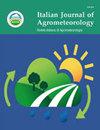使用基于区划的主成分分析预测伊朗未来农业气候的可变性和一致性
IF 1.6
4区 农林科学
Q2 AGRONOMY
Italian Journal of Agrometeorology-Rivista Italiana Di Agrometeorologia
Pub Date : 2023-01-29
DOI:10.36253/ijam-1557
引用次数: 2
摘要
气候变化对农业生态系统的影响可能引发相关问题。使用主成分分析(PCA),我们确定了在当前(1990-2019)和未来(2025、2050、2075和2100)条件下,伊朗44个天气站的67个农业气候指标(ACI)。根据联合国教科文组织干旱指数,使用农业生态区划(AEZ)对伊朗的地区(非常干燥、干燥、半干燥和潮湿的气候)进行分类。使用主成分分析方法,通过包括温度(冬季、春季、夏季和秋季最高和冬季最低温度)、降水量(冬季和夏季降水量)、参考蒸散量(ETref)和春季和冬季生长天数的数据集来确定前5个主成分,这解释了约96%的总方差。为每种气候选择了ETref的经验方程。为了准确评估ETref,在非常干燥的气候下分别使用基于FAO56(PM-FAO56)的Penman-Monteith方程、在半干燥气候下使用Hargreaves方程以及在干燥和潮湿气候下使用Penman-1和2方程。根据结果,仅第一个分量的特征值为41.15,就解释了总方差的74%以上。根据主成分分析结果的分区结果,1990-2019年的台站分为7个区。而2025年、2050年、2075年和2100年分别被划分为6个、7个、6个和5个区域。在该国未来的气候条件下,就气候指标而言,与当前条件相比,各站之间的相似性将增加,该国的气候多样性将下降。结果表明,主成分分析方法对于在半干旱气候下长时间监测AEZ是有价值的。本文章由计算机程序翻译,如有差异,请以英文原文为准。
Predicting Iran’s future agro-climate variability and coherence using zonation‑based PCA
The effects of climate changes on agroecosystems can cause relevant issues. Using principal component analysis (PCA) we determined the 67 agricultural climate indicators (ACI) at 44 of Iran’s synoptic stations under current (1990-2019) and future (2025, 2050, 2075, and 2100) conditions. Based on UNESCO aridity index, the agroecological zonation (AEZ) was used to classify Iran’s regions (very dry, dry, semidry and humid climates). Using the PCA method, the first 5 principal components were determined by including data sets for temperature (winter, spring, summer and autumn maximum and winter minimum temperature), precipitation (winter and summer precipitation), reference evapotranspiration (ETref), and the degree of growth days in spring and winter, which explained about 96 percent of the total variance. For each climate empirical equation for ETref was selected. In order to accurate evaluation of ETref were used The Penman-Monteith based on FAO56 (PM-FAO56) for the very dry climate, the Hargreaves equation for the semidry climate, and the Penman 1 and 2 equations for the dry and humid climates, respectively. According to the results, the first component alone, with an eigenvalue of 41.15, explained more than 74 percent of the total variance. Based on the results of zoning by the PCA outcomes, the stations for 1990-2019 were classified into 7 zones. While 2025, 2050, 2075, and 2100 were classified in 6, 7, 6, and 5 zones, respectively. Under the future climatic conditions of the country, in terms of climatic indicators, the similarity between the stations will increase and the climatic diversity of the country will decline compared to current conditions. The results demonstrated that the PCA method would be valuable for monitoring AEZ in semidry climates at reasonably long periods.
求助全文
通过发布文献求助,成功后即可免费获取论文全文。
去求助
来源期刊

Italian Journal of Agrometeorology-Rivista Italiana Di Agrometeorologia
AGRONOMY-ENVIRONMENTAL SCIENCES
CiteScore
2.10
自引率
8.30%
发文量
6
期刊介绍:
Among the areas of specific interest of the journal there are: ecophysiology; phenology; plant growth, quality and quantity of production; plant pathology; entomology; welfare conditions of livestocks; soil physics and hydrology; micrometeorology; modeling, simulation and forecasting; remote sensing; territorial planning; geographical information systems and spatialization techniques; instrumentation to measure physical and biological quantities; data validation techniques, agroclimatology; agriculture scientific dissemination; support services for farmers.
 求助内容:
求助内容: 应助结果提醒方式:
应助结果提醒方式:


